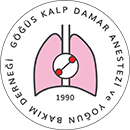

Torasik Cerrahi Geçiren Geriatrik Hastalarda Amerikan Anestezistler Derneği ve Modifiye Charlson Komorbidite Skorlarının Sağkalım Değerlendirmesi
Fatih Doğu Geyik, Yucel Yuce, Banu Cevik, Kemal SaracogluKartal Dr. Lütfi Kırdar Eğitim ve Araştırma HastanesiAmaç: Torasik cerrahi geçirmiş geriyatrik hastaların preoperatif American Society of Anesthesiology ve Modified Charlson Comorbidty Index skorları ile postoperatif sağkalım arasındaki ilişkiyi değerlendirmeyi amaçladık.
Yöntem: Bu retrospektif çalışmaya elektif koşullarda göğüs cerrahisi geçirmiş 65 yaş ve üzeri 109 hasta dahil edildi.
Bulgular: İlk iki yıl içinde ölen hastaların daha yüksek American Society of Anesthesiology III-IV skorları (p=0.03), daha yüksek Modified Charlson Comorbidty Index skorları (p=0.04) ve daha düşük hemoglobin ve hematokrit değerleri (sırasıyla p=0.02 ve p=0.005) vardı. Geriyatrik hastalar arasında Modified Charlson Comorbidty Index skorlarının iki yıllık mortaliteyi öngörmede anlamlı derecede etkili olduğunu bulduk (AUC=0.648,% 95 CI: 0.516-0.780, p=0.02). ROC analizinde, Modified Charlson Comorbidty Index için en iyi kestirim değeri 7 olarak bulundu (duyarlılık: %79.7, özgüllük: %44.4).
Tartışma: Cerrahi prosedür için hastaların dikkatli seçimi, ileride mortalitede iyileşmeye katkıda bulunabilir. Preoperatif testlerdeki iyileştirmeler ile ayrıntılı hasta seçimi yapılmaya devam edilmelidir.
Association of American Society of Anesthesiology and Modified Charlson Comorbidty Index Scores with Survival in Geriatric Patients Undergoing Thoracic Surgery
Fatih Doğu Geyik, Yucel Yuce, Banu Cevik, Kemal SaracogluKartal Dr. Lutfi Kirdar Education and Research HospitalObjective: We aimed to evaluate the relationship between preoperative American Society of Anesthesiology and Modified Charlson Comorbidty Index scores and postoperative survival in geriatric patients who had undergone thoracic surgery.
Methods: A total of 109 patients aged 65 years and above who had undergone thoracic surgery under elective conditions were included in this retrospective study.
Results: Patients who died within the first postoperative two years had higher American Society of Anesthesiology IIIIV scores (p=0.03), higher Modified Charlson Comorbidty Index scores (p=0.04), and lower hemoglobin and hematocrit values (p=0.02 and p=0.005, respectively). We found that Modified Charlson Comorbidty Index was significantly effective in predicting two-year mortality among geriatric patients (AUC = 0.648, 95% CI: 0.5160.780, p=0.02). In the ROC analysis, the best predictive cut-off value for Modified Charlson Comorbidty Index was found to be 7 (sensitivity: 79.7%, and specificity: 44.4%).
Conclusion: The cautious choice of patients for the medical procedure has contributed to the improvement in mortality rates after some time, and with refinements in preoperative testing meticulous patient selection should be maintained.
Makale Dili: İngilizce
(581 kere indirildi)

















